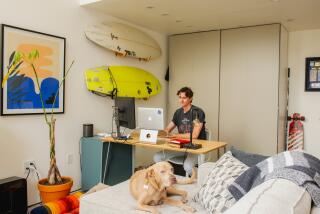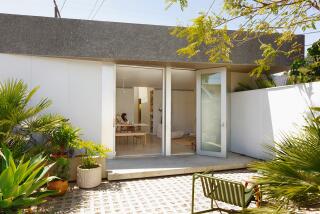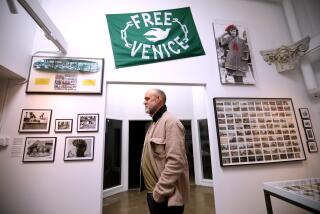Venice’s green cube
By Debra Prinzing
The exterior walls of the new wing of the Bricault family’s Venice home are clad in sedums and other succulents, which soften the contemporary architecture so it looks like a plush, verdant floating cube. Paul Bricault likes the way the horticultural house gets people talking.
“Everyone who comes here looks at it with this quixotic expression. We get all sorts of questions, including, ‘Do we have roots coming through the inside walls?”
The plants, including their roots, are actually contained by a modular green-wall system that Marc Bricault, Paul’s brother and a Vancouver, B.C.-based architect and furniture designer, specified while designing the 1,700-square-foot home addtion. Prior to the renovation, Paul, his wife, Cicek, and Marc had been intrigued on a trip to Paris by the vegetation-draped walls that designer Andrée Putnam installed at Hotel Pershing Hall. Marc also spent time in Japan, where he saw other inspiring examples of planted walls.
Those influences can be seen on three sides of the new master bedroom, which extends from a two-story section to create a carport below. The living walls are visually tied to the courtyard foliage and to a rooftop meadow and vegetable garden overhead. To create the planted walls, Marc researched a number of methods until he landed on a modular planted-panel system manufactured by ELT Easy Green in Ontario, Canada, and distributed in the U.S. The pre-planted cells are mounted on a membrane-moisture barrier and irrigated by captured rainwater.
Paul says the green cube generates so many inquiries that he keeps a stack of ELT’s brochures to hand out.
The planted addition is one of many greener lifestyle changes the Bricault family realized when they enlarged their pre-war Venice bungalow. Completed in 2008, the project has nearly doubled the home’s size while using passive cooling, solar panels and a rainwater recycling system -- among other sustainable construction approaches, indoors and out.
The Bricault home is one of 31 properties open to the public on May 1 on the Venice Garden & Home Tour. Gardens on the ground level and roof and portions of the Bricault home are included on the tour, which benefits the Neighborhood Youth Assn.’s Las Doradas Children’s Center. It was only fitting to agree to join the event, Cicek says. “When we first bought our home, we went on the Venice tour and were so charmed by seeing other people’s gardens. To open up our home for this year’s tour hits a sweet spot for us.”
The couple -- Paul, who is working in local venture capital after spending 16 years as a partner at William Morris Endeavor, and Cicek, a longtime producer and designer of online communities -- liked the vintage cottage when they first saw it as newlyweds in 2000. Originally a 515 square-foot beach house built in 1911, the residence had been given a contemporary, 1,000-square-foot addition in the 1990s by previous owners. “The older facade gives a nod to the history of Venice, but when you walk inside, it is modern with 25-foot ceilings,” Cicek says.
By 2006, though, after the births of their children, the couple thought about finding something larger or expanding to add more bedrooms. Paul says he was influenced by two advisers. His architect-brother Marc “convinced us that even though the footprint of our lot was small, we could do a lot with the space by expanding to the second level.” -to-
Paul also was inspired by a chance meeting with “cradle to cradle” sustainability guru William McDonough, whom he met in 2005 at a conference in China and later reconnected with at a TED gathering. “I became friendly with him and his cutting-edge work on green architecture internationally,” Paul says. “When we started the house, I called Bill for counsel and he sent us to Bill Wilson, who designed our water retaining system.”
Cheered by the discovery that their 5,000-square-foot lot could accommodate more house, Paul and Cicek began to re-imagine their environment in a new way. “We felt like we had an open canvas for being creative,” Cicek says. “And we decided to go as green as we could.” They didn’t have a huge wish list other than asking Marc to make the addition “neighbor-friendly,” and to give them a roof garden.
Marc Bricault’s design solution begins with an open connection between the dining-kitchen area and a glassed-in family room that Paul and Cicek call the “terrazzo terrarium.” The room’s east wall faces a semi-transparent fence that allows morning light to filter through plantings and illuminate the interiors. The room’s west wall is connected to the 475-square-foot “courtyard” via five side-by-side, fir-and-glass doors. The massive doors pivot open, leading to a terrazzo ledge that floats above the tiny garden, where flowering shrubs and vines attract hummingbirds and other pollinators. When the doors are open, the space feels more like an open-air pavilion than a room; in fact, Marc calls it a “breezeway.” Its shaggy green wool rug playfully suggests indoor grass on top of the terrazzo floor. In the northeast corner of the room, a curved steel-and-walnut staircase leads upstairs to the second floor and rooftop garden.
Paul and Cicek are pleased that the see-through addition feels inviting. “We did not want a fortress house with completely opaque walls all the way around,” Paul says. “We wanted to see our neighbors through the windows and not be closed off from them.” Their connection to pedestrians and passersby extends to the alley, where strangers often stop to thank Paul and Cicek for beautifying an otherwise neglected thoroughfare. “It was a gesture from Marc to create a pretty thing for people to look at,” she says.
By elevating most of the new square footage to the second level, the addition doesn’t feel claustrophobic, Paul says. “Even though we reduced the footprint of the backyard, it now feels even larger, because of the accessibility of the addition and an indoor-outdoor connection.”
On the roof, the staircase tower doubles as a funnel to draw cool air to the interior. It opens onto a green meadow planted with native grasses; walkways and decking are made from Trex, a recycled composite material. The vegetable garden only takes up a 3-by-12 foot slice, but it is “one of the biggest draws that pulls everyone to the roof,” Marc adds.
“I have an amazing amount of produce up there -- including artichokes, cucumbers, zucchini, tomatoes, peppers, celery, parsley, blueberries, raspberries, strawberries, plus a lemon and orange tree,” Paul says. “People think you need massive amounts of space or a big backyard, but this is just a tiny triangle.”
The Bricault brothers were raised in Canada by parents who worked for the country’s Department of Environment. “Our father used to foster our interest in nature by teaching us the Latin names of plants,” Paul says. “You do that for our children now,” Cicek says, adding that 6-year-old Melise and 4-year-old Destin usually agree to try her cooking “ if the ingredients come from the roof.”
The Bricault youngsters don’t spend all of their time gardening, though. They can often be found playing in the secret hideout that occupies the narrow space between the home and the church next door,. Marc built it as a surprise for them, recycling extra building material instead of taking it to the landfill. “All that leftover lumber and tile was piled up near the alley and - MacGyver-like - Marc turned it into a little playhouse,” Paul says. “We added recycled rubber tires on the ground so the children can bounce around. It’s their own backyard sanctuary.”
Cicek plans to add one final touch to the play area when her mother, an artist, visits later this summer. “We’re going to paint a mural on the wall with the children,” she says.
The Bricault house:
Architect: Marc Bricault, Bricault Design, Vancouver, B.C. (www.bricault.ca)
Contractor: Martin Leon and Gabriel Simon, Alisal Builders, Marina del Rey (www.alisalbuilders.com)
Interior millwork: Richard Draut, Blue Sand Construction, Venice ([email protected])
Landscape design: Richard Grigsby, the Great Outdoors Landscape Design & Construction, Topanga
Environmental consultant: Bill Wilson, Bill Wilson Environmental Planning, Mill Valley, Calif.
Venice Garden & Home Tour
Start location: Las Doradas Children’s Center, 804 Broadway (corner of Broadway and Pleasant View Avenue, one block west of Lincoln Boulevard), Venice
Time: 10 a.m. to 5 p.m. (rain or shine)
Date: May 1
Tickets: $60 in advance (until 3 p.m. on April 30), $70 at the door
Children under 12 are admitted free
Contact: (310) 821-1857 or https://www.venicegardentour.org






